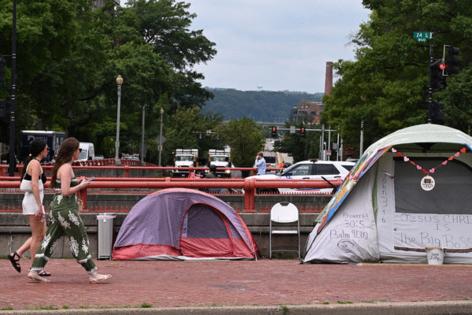Editorial: Hiding the homeless won't solve the problem
Published in Op Eds
The White House has promised swift action on homelessness. It aims to dismantle encampments, force addicts and the mentally ill into treatment, and yank federal funds from cities that refuse to police tents and open-air drug use. For residents exasperated by sidewalk squalor, that sounds like overdue toughness.
In reality, casting the homeless as nothing more than a public nuisance understates the crisis and diverts money and attention from the broader solutions that are needed.
Encampments are only the visible edge of a wider emergency. Roughly two-thirds of unhoused Americans spend nights in cars, motels or overcrowded shelters. From 2023 to 2024, the number of people experiencing homelessness nationally jumped 18%, with the fastest growth among families. Behind those numbers is a structural shortage of low-rent homes — over 7 million units by the latest count — while Medicaid and mental-health systems remain threadbare and under attack from the administration.
There are no quick fixes, but progress is possible. Since 2009, veteran homelessness has fallen 55% because Congress paired long-term rent subsidies with case management and health care through a single, accountable system. Houston used the same “housing first” formula, with placement in permanent housing plus voluntary services, to cut its homeless count by over 60%. Similar methods have worked well in cities abroad. For example, Helsinki used them to push street homelessness to near zero (until recent cuts to support let it reappear).
All successful programs recognize that stable shelter is essential. A settled address is a place to sleep in safety, use medicines as directed, and store important documents and belongings. Randomized trials have shown that housing-first approaches, especially when linked with health and other services, work better for many of the homeless — and far less expensively — than rotating people through emergency wards and county jails.
Short-term rental aid, emergency cash after a job loss and legal help in preventing evictions all reduce entries into shelters. States and cities should reform the zoning rules that throttle construction of small, inexpensive apartments. Federal housing vouchers — which help offset housing costs for some 2 million low-income households — are effective, but demand dwarfs supply and most eligible families never get them. Studies show vouchers don’t deter work, and the cost is less than what would otherwise be spent on recurring emergency-room visits, police interventions and stays in jail.
Granted, these approaches are most likely to succeed with those in shelters; tackling chronic street homelessness is harder, because mental illness and drug addiction play a bigger role. The White House’s plan concentrates on this second group. It seeks to bar federal housing help from anyone who cannot pass a sobriety test and funnels dollars from prevention to policing. It urges states to expand “civil commitments” without saying where the subjects will be sent, how they will be treated or how they’ll eventually exit.
The focus on street homelessness, which amounts to a breakdown of public order, is understandable, and more civil commitments to medical facilities are necessary. But residential treatments for addiction and mental illness aren’t cheap. More funding is needed. Short of compulsory removal, mobile health teams that pair clinicians with outreach workers can reduce street homelessness cost-effectively, reducing both 911 calls and arrests.
The public’s impatience with homelessness and the disorder that goes with it is justified, but simply hiding the homeless isn’t the answer. The right kind of help — housing plus treatment and other services — isn’t just more humane. Anything less is bound to fail.
____
The Editorial Board publishes the views of the editors across a range of national and global affairs.
©2025 Bloomberg L.P. Visit bloomberg.com/opinion. Distributed by Tribune Content Agency, LLC.

























































Comments